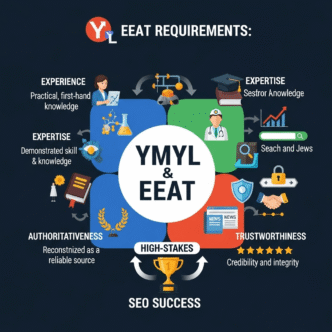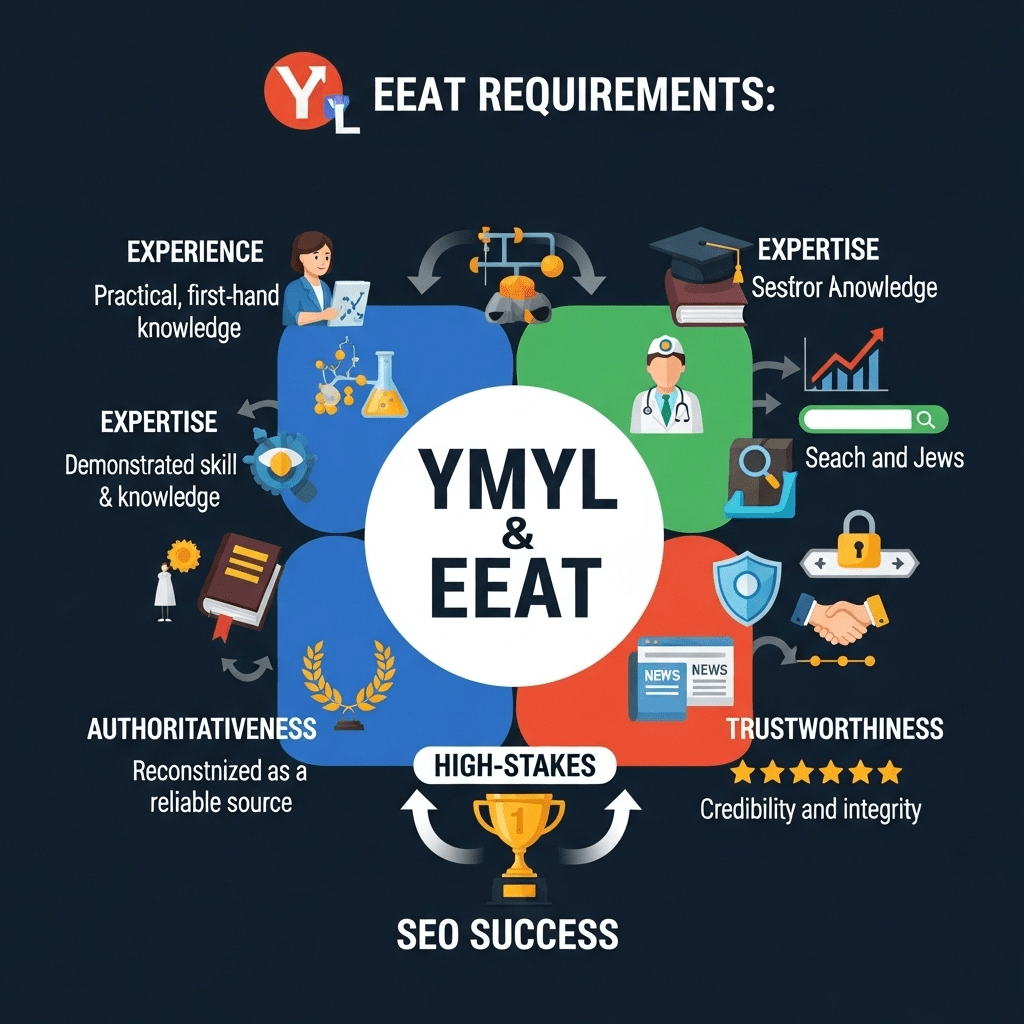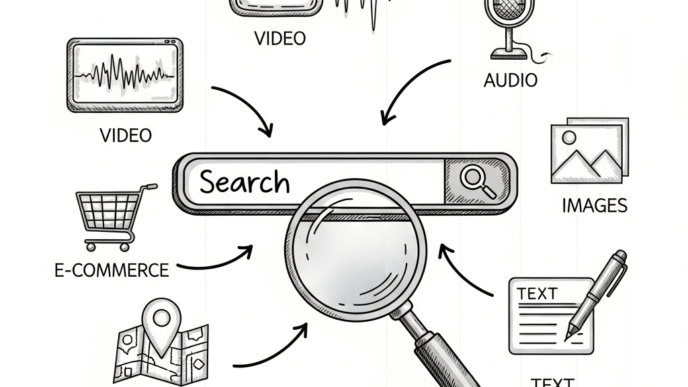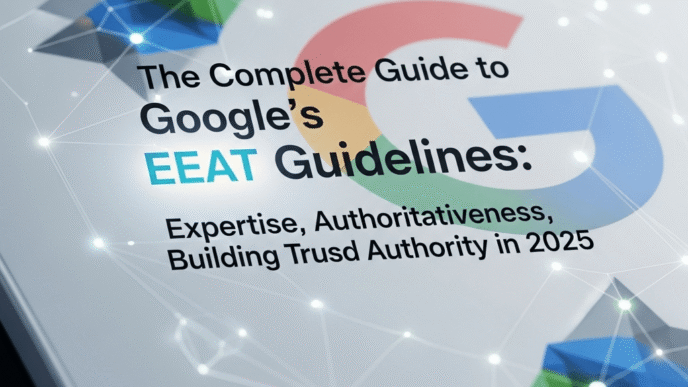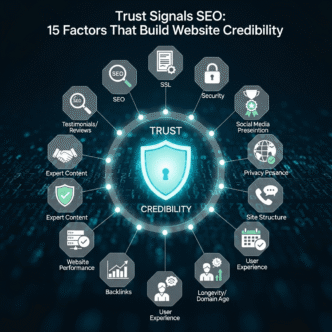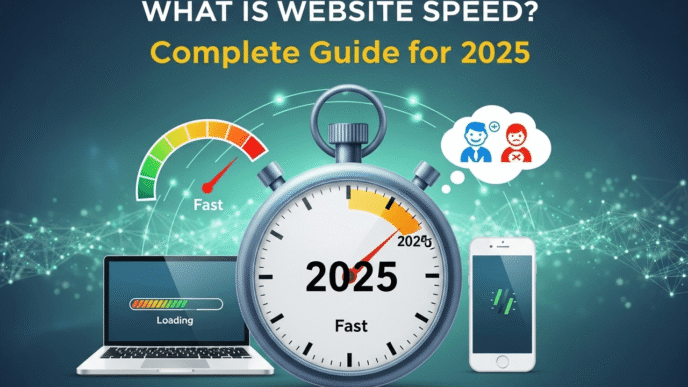Ever wondered why some health and finance websites get slammed by Google updates while others seem bulletproof? Here’s the uncomfortable truth: if you’re publishing Your Money or Your Life content without understanding YMYL EEAT requirements, you’re essentially playing Russian roulette with your rankings.
One day you’re ranking #1 for “best investment strategies,” and the next day you’ve vanished from search results entirely. Sound familiar? You’re not alone – countless websites in health, finance, and safety niches have learned this lesson the hard way.
The stakes couldn’t be higher when you’re dealing with YMYL EEAT requirements. Unlike regular blog posts about “10 best pizza toppings,” YMYL content directly impacts people’s health, wealth, safety, and happiness. Google knows this, and they’ve built a fortress of quality requirements around it.
Understanding Google’s comprehensive approach to trust and authority becomes absolutely critical when your content could influence someone’s medical decisions or financial future.
Table of Contents
Toggle
What Are YMYL EEAT Requirements and Why They’re Make-or-Break
YMYL EEAT requirements represent Google’s most stringent content quality standards, applied specifically to “Your Money or Your Life” topics that could significantly impact a person’s health, financial stability, safety, or well-being.
Think of YMYL EEAT requirements as Google’s way of saying: “If you’re going to give advice that could affect someone’s life, you better prove you know what you’re talking about.” And they’re not kidding around.
The consequences of ignoring these requirements aren’t just lower rankings – they’re complete search visibility annihilation. We’re talking about 80-95% traffic drops overnight when major algorithm updates hit sites with poor YMYL compliance.
The Four Pillars Applied to High-Stakes Content
Experience in YMYL: Have you actually lived through what you’re advising about? A diabetes patient sharing management tips carries more weight than a health blogger who’s never dealt with the condition.
Expertise in YMYL: Do you have the professional qualifications to give this advice? Medical degrees for health content, financial certifications for investment advice, legal credentials for legal guidance.
Authoritativeness in YMYL: Are you recognized by peers and institutions in your field? Published research, professional associations, media citations all matter exponentially more in YMYL spaces.
Trustworthiness in YMYL: Can people trust you with decisions that affect their money, health, or safety? This includes everything from transparent funding sources to clear editorial processes.
Pro Tip: “YMYL content isn’t just held to higher standards – it’s held to the highest possible standards. If you wouldn’t feel comfortable giving this advice to your own family member, you probably shouldn’t publish it as YMYL content.”
What Are YMYL EEAT Standards According to Google’s Guidelines?
Understanding what are YMYL EEAT standards requires diving into Google’s specific quality requirements for high-impact content categories.
Google’s Official YMYL Categories
Health and Medical Information:
- Medical conditions, treatments, medications
- Mental health and wellness advice
- Nutrition and supplement recommendations
- Healthcare provider information
Financial Advice and Services:
- Investment and trading guidance
- Tax and financial planning advice
- Insurance recommendations
- Banking and loan information
Safety and Legal Information:
- Home and auto safety advice
- Legal guidance and procedures
- Emergency preparedness information
- Child safety recommendations
Major Life Decisions:
- Career and education choices
- Parenting and childcare advice
- Real estate and major purchases
- Relationship and family guidance
Quality Standards by Category
| YMYL Category | Minimum Author Requirements | Content Standards | Consequences of Poor Quality |
|---|---|---|---|
| Medical/Health | Licensed healthcare professionals | Peer-reviewed sources, current research | 90-95% traffic loss potential |
| Financial Advice | Certified financial professionals | Regulatory compliance, disclaimers | Severe ranking penalties |
| Legal Information | Licensed attorneys | Current law references, jurisdiction clarity | Complete de-indexing possible |
| Safety/Emergency | Certified safety experts | Life-threatening accuracy required | Immediate manual review risk |
YMYL EEAT Requirements for Health Websites: The Ultimate Challenge
YMYL EEAT requirements for health websites represent perhaps the most stringent content standards on the entire internet. One poorly sourced medical claim can torpedo your entire domain’s credibility.
Essential Health Content Compliance
Author Credentials Requirements:
- Board-certified physicians for medical advice
- Licensed nutritionists for diet recommendations
- Certified mental health professionals for psychological guidance
- Peer-reviewed publication history preferred
Content Sourcing Standards:
- Primary sources from medical journals
- Recent research (within 2-3 years for evolving topics)
- Government health organization citations
- Professional medical association references
Editorial Oversight Necessities:
- Medical review boards for content approval
- Regular content audits and updates
- Clear editorial policies and disclosure
- Fact-checking processes with medical experts
Real-World Case Study: Healthline’s YMYL Success
Healthline demonstrates excellent health content SEO through rigorous YMYL content guidelines:
Medical Review Process: Every article reviewed by board-certified physicians before publication
Source Requirements: Only peer-reviewed medical journals and official health organizations cited
Author Standards: Content written by medical professionals or journalists with health backgrounds
Update Protocols: Regular reviews to ensure medical accuracy as research evolves
Results: Consistently ranks #1 for competitive health terms while maintaining Google’s trust through algorithm updates.
Their secret: They treat every piece of content as if someone’s life depends on it – because it might.
How to Optimize YMYL Content for Google’s Algorithm
Understanding how to optimize YMYL content for Google requires a fundamentally different approach than regular SEO content creation.
The YMYL Optimization Framework
Step 1: Credential Verification and Display
- Showcase relevant professional licenses prominently
- Link to official certification databases
- Display educational background and specialized training
- Include professional association memberships
Step 2: Source Authority Maximization
- Prioritize government and medical institution sources
- Use only peer-reviewed research for claims
- Link to original studies, not secondary reporting
- Maintain citation currency (prefer recent sources)
Step 3: Editorial Process Transparency
- Document your content review process publicly
- Identify medical/financial reviewers by name and credentials
- Establish clear content update schedules
- Provide contact information for content questions
Step 4: Legal and Ethical Compliance
- Include appropriate disclaimers for medical/financial advice
- Clarify when content is educational vs. prescriptive
- Ensure HIPAA compliance for health content
- Follow FTC guidelines for financial recommendations
Advanced YMYL SEO Tactics
Expertise Amplification: Collaborate with multiple credentialed experts for comprehensive coverage
Authority Building: Seek mentions and links from established medical/financial institutions
Trust Signal Enhancement: Implement robust privacy policies, secure data handling, and transparent funding disclosure
Content Depth: Provide comprehensive coverage that addresses user questions completely and safely
Understanding these principles within the broader context of Google’s trust and authority framework ensures your YMYL content meets the highest standards.
YMYL Content Quality Guidelines 2025: What’s Changed
The YMYL content quality guidelines 2025 have evolved significantly, reflecting Google’s increasing sophistication in evaluating high-stakes content.
Key Updates and Changes
Enhanced AI Detection: Google’s systems now better identify AI-generated medical and financial content lacking human expertise
Stricter Author Requirements: Increased emphasis on verifiable professional credentials and real-world experience
Faster Penalty Implementation: Algorithm updates now impact YMYL sites within days rather than weeks
Cross-Platform Validation: Google now checks author credentials across multiple platforms and databases
2025 Compliance Checklist
Author Verification:
- [ ] Professional licenses verified and current
- [ ] Credentials cross-referenced with official databases
- [ ] Real-world experience documented with specific examples
- [ ] Professional photos and contact information provided
Content Standards:
- [ ] All medical claims supported by peer-reviewed research
- [ ] Financial advice includes appropriate risk disclaimers
- [ ] Legal information specifies jurisdiction and currency
- [ ] Safety advice reviewed by certified professionals
Technical Implementation:
- [ ] Schema markup identifying content authors and reviewers
- [ ] SSL certificates and secure data handling
- [ ] Mobile optimization for accessibility
- [ ] Fast loading speeds for emergency information access
Editorial Processes:
- [ ] Documented review process with credentialed experts
- [ ] Regular content audits and update schedules
- [ ] Clear editorial policies publicly available
- [ ] Contact information for content corrections
EEAT Requirements for Financial Content: Banking on Credibility
EEAT requirements for financial content demand exceptional attention to regulatory compliance, professional credentials, and user protection.
Financial Content Authority Standards
Professional Certification Requirements:
- Certified Financial Planner (CFP) for financial planning advice
- Chartered Financial Analyst (CFA) for investment guidance
- Certified Public Accountant (CPA) for tax advice
- Licensed attorneys for legal financial matters
Regulatory Compliance Necessities:
- SEC registration for investment advice
- FINRA compliance for securities recommendations
- State licensing for insurance advice
- Banking regulation adherence for lending guidance
Content Disclosure Standards:
- Clear disclaimers about investment risks
- Conflicts of interest transparency
- Compensation disclosure for recommendations
- Professional liability insurance information
Case Study: NerdWallet’s Financial Authority
NerdWallet exemplifies excellent finance content quality through comprehensive YMYL website requirements:
Expert Network: Certified financial planners and analysts on staff
Transparency: Clear disclosure of how they make money from recommendations
Regulatory Compliance: SEC-registered investment advisor subsidiary
User Protection: Extensive disclaimers and risk warnings
Editorial Standards: Multi-layer review process for all financial advice
Result: Maintained strong rankings through multiple financial algorithm updates while building user trust.
Medical Content Standards: Life-and-Death SEO
Medical content standards represent the most stringent YMYL EEAT requirements because the stakes literally involve life and death decisions.
Healthcare Content Compliance Framework
Medical Professional Requirements:
- Board certification in relevant medical specialties
- Active medical licenses in good standing
- Hospital affiliations or practice associations
- Continuing education documentation
Content Accuracy Standards:
- Alignment with established medical consensus
- Current research reflecting latest medical knowledge
- Clear distinction between established and experimental treatments
- Appropriate medical terminology usage
Patient Safety Priorities:
- Emphasis on consulting healthcare providers
- Clear warnings about self-diagnosis dangers
- Emergency situation guidance with immediate care instructions
- Mental health crisis resources and hotlines
Medical Content Verification Process
Pre-Publication Review:
- Medical expert review for accuracy and safety
- Legal review for liability and disclaimer adequacy
- Patient safety assessment for potential harm
- Accessibility review for diverse populations
Post-Publication Monitoring:
- Regular medical accuracy audits
- Patient feedback integration and response
- Medical research update incorporation
- Adverse event monitoring and response
The foundation for all successful YMYL content lies in implementing comprehensive authority and trust building strategies that prioritize user safety above all else.
YMYL SEO Strategy: Beyond Basic Optimization
Developing an effective YMYL SEO strategy requires understanding that traditional SEO tactics often backfire in high-stakes content environments.
Strategic Approach Differences
Traditional SEO Focus: Keyword optimization, link building, technical performance
YMYL SEO Focus: Credibility verification, expert validation, user safety
Traditional Content Goals: Traffic generation, engagement metrics, conversion optimization
YMYL Content Goals: User protection, accurate information delivery, professional reputation building
Advanced YMYL Strategy Components
Multi-Expert Collaboration:
- Primary expert authors with relevant credentials
- Secondary expert reviewers for accuracy verification
- Legal experts for compliance and liability review
- Patient advocates for accessibility and understanding
Institutional Partnerships:
- Medical school affiliations for health content
- Financial institution partnerships for economic advice
- Legal organization connections for legal guidance
- Government agency relationships for safety information
Community Engagement:
- Professional forums and discussion participation
- Industry conference speaking and attendance
- Peer-reviewed publication contributions
- Professional association active membership
Common YMYL EEAT Mistakes That Destroy Rankings
Understanding common pitfalls helps avoid the devastating consequences of YMYL EEAT requirements violations.
The “Fake Expert” Catastrophe
Mistake: Using unqualified authors or fabricated credentials for YMYL content
Real Consequences: Complete domain de-indexing and potential legal liability
Example: Health websites using “Dr.” titles for non-medical degree holders
Solution: Verify and display authentic professional credentials with verifiable sources
The “Outdated Information” Disaster
Mistake: Publishing medical or financial advice based on superseded research or regulations
Real Consequences: User harm and immediate algorithm penalties
Example: Recommending medications that have been recalled or investment strategies based on outdated tax laws
Solution: Implement rigorous content update schedules with expert review processes
The “Generalized Advice” Problem
Mistake: Providing specific medical or financial recommendations without appropriate disclaimers
Real Consequences: Legal liability and loss of search engine trust
Example: Recommending specific medications without “consult your doctor” disclaimers
Solution: Always emphasize individual professional consultation for specific decisions
The “Source Quality” Failure
Mistake: Citing unreliable sources or secondary reporting for medical/financial claims
Real Consequences: Content authority destruction and ranking penalties
Example: Using blog posts or non-peer-reviewed sources for medical advice
Solution: Maintain strict source quality standards with peer-reviewed research requirements
Pro Tip: “In YMYL content, the cost of getting it wrong isn’t just poor rankings – it’s potential harm to real people making important life decisions based on your content. Always err on the side of caution and professional consultation.”
Measuring YMYL EEAT Success: Metrics That Matter
Traditional SEO metrics don’t tell the complete story for YMYL content credibility standards performance.
Essential YMYL Performance Indicators
Trust Metrics:
- User return rate and session duration
- Direct traffic growth (indicating brand trust)
- Social sharing from credentialed professionals
- Mentions in professional publications
Authority Indicators:
- Citations by other expert websites
- Invitations to speak at professional conferences
- Media requests for expert commentary
- Professional association recognition
Safety Metrics:
- User feedback quality and sentiment
- Correction request frequency and response time
- Professional peer review scores
- Compliance audit results
Advanced YMYL Analytics
Content Performance by Credential Level:
- Traffic comparison between high-credential vs. lower-credential content
- Engagement metrics correlation with author expertise
- Conversion rates for different expert authority levels
Trust Signal Impact Analysis:
- Effect of author bio completeness on rankings
- Impact of credential verification on user behavior
- Correlation between source quality and search performance
Building Long-Term YMYL Authority
Sustainable success with content credibility standards requires long-term authority building rather than quick optimization tactics.
Authority Development Timeline
Months 1-3: Foundation Building
- Establish basic compliance with all YMYL requirements
- Implement proper author credential display
- Develop editorial review processes
- Create content update and monitoring systems
Months 4-6: Credibility Enhancement
- Build relationships with other industry experts
- Seek speaking opportunities at professional events
- Contribute to peer-reviewed publications
- Develop original research or case studies
Months 7-12: Authority Expansion
- Launch collaborative content with recognized experts
- Establish institutional partnerships and affiliations
- Create comprehensive resource libraries
- Develop educational programs or certifications
Year 2+: Industry Leadership
- Become a quoted expert source for media
- Lead industry discussions and policy development
- Mentor other professionals in your field
- Influence industry standards and best practices
For comprehensive guidance on building sustainable authority across all content types, explore our detailed framework for Google’s trust and authority principles.
Crisis Management for YMYL Content
When YMYL EEAT requirements violations occur, rapid response can mean the difference between recovery and permanent damage.
Emergency Response Protocol
Immediate Actions (Within 24 Hours):
- Identify and remove or correct inaccurate information
- Add appropriate disclaimers and safety warnings
- Contact affected users if possible
- Document the issue and response actions
Short-Term Recovery (1-4 Weeks):
- Conduct comprehensive content audit with expert review
- Implement enhanced editorial processes
- Strengthen author credential verification
- Improve source quality standards
Long-Term Rebuilding (3-12 Months):
- Rebuild search engine trust through consistent quality
- Seek professional endorsements and partnerships
- Develop reputation management strategies
- Monitor and respond to user feedback continuously
Legal and Ethical Considerations
Professional Liability: Ensure appropriate insurance coverage for advice-giving content
Regulatory Compliance: Stay current with evolving regulations in your YMYL category
User Privacy: Implement robust data protection for health and financial information
Transparency: Maintain clear disclosure of funding sources, conflicts of interest, and limitations
Advanced YMYL Optimization Techniques
Sophisticated YMYL SEO strategy implementation requires advanced techniques beyond basic compliance.
Expert Network Development
Building Professional Relationships:
- Cultivate relationships with board-certified experts
- Develop content collaboration agreements
- Create expert advisory boards for content oversight
- Establish peer review networks for quality assurance
Institutional Connections:
- Partner with medical schools or financial institutions
- Seek affiliations with professional associations
- Develop relationships with regulatory bodies
- Connect with research institutions for latest findings
Content Innovation for YMYL
Interactive Expert Content:
- Live Q&A sessions with credentialed professionals
- Expert-moderated discussion forums
- Professional webinar series
- Case study development with expert analysis
Multi-Media Authority Building:
- Expert interview podcasts
- Professional video content with certified experts
- Interactive tools developed with professional oversight
- Educational course content with expert instruction
Future-Proofing Your YMYL Strategy
The landscape of YMYL content guidelines continues evolving, requiring adaptive strategies for long-term success.
Emerging Trends in YMYL Evaluation
AI-Enhanced Quality Detection: Google’s systems increasingly sophisticated at identifying genuine expertise vs. superficial authority signals
Cross-Platform Credibility Verification: Integration of professional licensing databases and credential verification systems
Real-Time Content Monitoring: Faster identification and response to quality issues
User Feedback Integration: Increased weight given to professional and user community feedback
Preparation Strategies
Technology Adaptation: Stay current with new tools for credential verification and content quality assessment
Professional Development: Continuously enhance your own credentials and those of your content team
Industry Engagement: Maintain active participation in professional communities and ongoing education
Quality System Evolution: Regularly update and improve your editorial and review processes
Understanding and implementing proper Google’s authority building framework provides the foundation for long-term YMYL content success.
Your YMYL EEAT Implementation Action Plan
Ready to transform your high-stakes content into authority-building assets? Here’s your step-by-step implementation guide.
Week 1-2: Compliance Assessment
Content Audit:
- Review all YMYL content for compliance gaps
- Identify missing author credentials and expertise gaps
- Assess source quality and currency
- Evaluate disclaimer and disclosure adequacy
Team Evaluation:
- Verify current team member credentials
- Identify gaps in professional expertise
- Plan for additional expert recruitment or consultation
- Establish budget for professional review services
Month 1: Foundation Implementation
Author Profile Enhancement:
- Create comprehensive author bios with credential verification
- Link to professional licensing databases where applicable
- Display educational background and specialized training
- Include professional photos and contact information
Content Standards Development:
- Establish source quality requirements
- Create editorial review processes
- Develop update and monitoring schedules
- Implement disclaimer and disclosure standards
Month 2-3: Quality System Establishment
Expert Network Building:
- Recruit credentialed professionals for content review
- Establish ongoing consultation relationships
- Create content collaboration agreements
- Develop expert advisory board structure
Content Enhancement:
- Update existing content to meet new standards
- Implement comprehensive source citation
- Add appropriate disclaimers and safety warnings
- Enhance content depth and professional accuracy
Month 4+: Authority Building and Optimization
Professional Engagement:
- Seek speaking opportunities at industry events
- Contribute to professional publications
- Participate in expert panels and discussions
- Build relationships with institutional partners
Continuous Improvement:
- Monitor content performance and user feedback
- Conduct regular quality audits with expert review
- Stay current with industry developments and regulations
- Adapt strategies based on algorithm updates and guideline changes
The foundation for all successful YMYL content strategies lies in implementing comprehensive trust and authority building principles that prioritize user safety and professional integrity above all other considerations.
Final Verdict: YMYL EEAT Excellence as Your Competitive Advantage
Mastering YMYL EEAT requirements isn’t just about avoiding penalties – it’s about building sustainable competitive advantages in the highest-value content categories.
The High-Stakes Reality
The Stakes: YMYL content affects real people’s health, wealth, safety, and happiness. Google knows this, and they’ve built the most stringent quality requirements around it.
The Opportunity: Most websites fail at YMYL compliance, creating massive opportunities for those who get it right.
The Investment: Building proper YMYL authority requires significant investment in professional expertise, but the returns are exponentially higher than regular content.
Success Principles for YMYL Mastery
Authenticity Over Optimization: Focus on genuine professional expertise rather than SEO tricks
Safety Over Traffic: Prioritize user safety and accurate information over traffic generation
Quality Over Quantity: Better to publish less content that meets the highest standards than more content that doesn’t
Relationships Over Rankings: Build genuine professional relationships that naturally create authority
Your YMYL Success Formula
Professional Credibility + Editorial Excellence + User Safety = YMYL Authority
The websites that dominate YMYL search results in 2025 won’t be those with the best SEO tactics – they’ll be those with the most authentic professional expertise and the strongest commitment to user safety.
Your professional credentials and genuine expertise are your greatest SEO assets in the YMYL world. Use them wisely, display them prominently, and always remember that real people are making important life decisions based on your content.
The question isn’t whether you can afford to invest in proper YMYL compliance – it’s whether you can afford not to when people’s health, wealth, and safety are at stake.
This comprehensive guide on YMYL EEAT requirements represents current best practices and Google’s stated quality standards as of 2025. Always verify the latest guidelines and prioritize user safety in all high-stakes content decisions.
